Link
This particular article brought to my attention a vital element of tech marketing in which I had not questioned before: when it comes to these tech products, where is the scientific evidence proving these devices and apps actually teach infants, toddlers and preschoolers? I have generally assumed that because these are notable tech companies studies and research must have been conducted. However, just like the battle between food corporations and their deceptive labeling, it is not far-fetched to think tech industries may mislead customers with promising educational advantages for children. Jane Margolis, senior researcher at the U.C.L.A., and Yasmin Kafai, University of Pennsylvania professor state, “Teaching and learning of computer science, a subject that drives innovation across all fields, must not be confused with the pouring of more technology into the schools.” I believe that the study of computer science is extremely vital, but I also agree with the previous statement that it should not be confused with overloading schools with more gadgets. There is a difference, as I have declared before, there needs to be a specific purpose in mind when using technology. Endless browsing, a stream of YouTube videos, and countless apps do not serve a specific purpose, especially for children. The art of coding and designing systems takes legitimate skills such as critical thinking, problem-solving, and decision-making, which is what we should teach our children about technology rather than letting technology teach our children about the world. The false promises tech companies make to parents often leads them to believe that not only will their job be easier with a tablet, but their children also benefit as well. Without thorough research, we really do not know if these apps will help children learn or give them an advantage in school. I believe there are a few companies who have the consumers best interest at heart, especially products designed to help children and toddlers with impairments. Hopefully, as time progresses thorough research will be conducted and scientific evidence collected for accurate product depictions. Along with finding a balance, we will be one step closer to cohesion.
2 notes
·
View notes
Link
The recent study published in the Journal of Pediatrics released very astounding numbers. The study involved 6-month-old to four-year-old children. Approximately 50% of babies under the age of one are using a mobile device for 20 minutes per day, and nearly 80% by the time they are two years old. I personally have a hard time understanding why parents would allow their babies and toddlers to play on smartphones at that age. The article goes on to state that 70% of parents allow smartphones when a child does their chores, 65% to keep their child calm in public places, 58% to run errands, and 28% to put their child to sleep. Although I believe there are other accolades that can be given out when a child completes their chores, I do understand how this could be considered a reward in today’s society. However, giving a child a smartphone to calm them, run errands, or put them to sleep sounds a bit absurd. Relying on a device to distract them from throwing fits essentially deprives them of learning how to work out their feelings. Instead of giving them smartphones, it is the parent’s responsibility to engage with their children, even when they are running errands. I have been to the grocery store countless times to see toddlers in the cart on their parent’s iPhone when they could be building memories, learning essential life skills, or socializing. After witnessing my own daughter’s behavior during the brief time we let her play with our cell phones, we decided it was not in her best interest. She easily became disconnected from the world around her. We downloaded educational apps and yet, within a week span, she learned how to navigate out of the apps and found YouTube where she watched video after video. When we said phone time was up she lost her temper and we literally had to pry the phone from her hands. After that experience, we vowed our kids would not have a smartphone or tablet until they are teenagers and even then there will be strict guidelines. The study concluded that future studies are needed to assist professionals and families on the best way for children to use them.
0 notes
Link
Another innovative game for children with learning and social disabilities. This is truly a creative way to help autistic children with their social skills. The game, Frankie and Friends, was developed to help kids prioritize people and more particularly faces in social interactions. Aiding children in doing so can have a major impact with their socialization. I really support kids and screen time when it is has a clear intention and purpose. Although the game has not officially been released, it is very promising to know it is in the works. Before releasing the game to the public, researcher, Gail Alvares, stated that they would be conducting thorough trials to ensure the game's effectiveness. I really appreciate that Alvares is more interested in gathering data and proof that the product actually helps rather than making a profit. She even states that parents with autistic children are already asked to do so much. Although my children are not autistic, I can relate to the idea of games and apps made to help children when certain disorders and disabilities. My daughter is too young to really determine how nystagmus will affect her but if it turns out she needs extra attention and stimulation, I hope their will products like this to aid us. I am starting to realize that technology and screen time that serve a certain purpose is an amazing asset. It is also important to recognize our good fortune to have the ability to own such products.
0 notes
Link
Even though I am not a huge fan of apps for babies or toddlers, I have to acknowledge the initiative of this specific app. Tiggly uses colored geometric shapes that interact with the app when placed on the screen. When placed in the correct position the shapes on the screen transform into cute characters. The shapes can also be used in a variety of other games as stamps and drawing tools. I think the concept of combining physical toys and digital gadgets is a great idea. It creates the balance needed for both. These games are meant to encourage language development, creativity, spatial thinking and motor skills. The app is currently $24.99 and has a 4.5/5 rating on Amazon. It is a little pricey, especially for an app, but the benefits of this type of app outweigh those of other apps that do not use a similar concept. I believe if there are more apps that incorporate physical toys, such as this, babies and toddlers will benefit more from the interaction. Again, these apps should not be solely relied on to teach our youth. Toddlers also need the age-old toys such as building blocks, and puzzles to help develop motor skills and cognitive development using their hands and their brains. I believe children’s imaginations not only soar with toys they can build and piece together but they also feel a certain type of accomplishment. When my daughters play with blocks they often look for recognition when stacking, as well as when they successfully put together correct puzzle pieces. That special recognition they crave can only come from the parent. The “good job” they receive from the screen can never replace the hugs and high fives from a parent or caregiver. I have personally seen the joy and excitement on my daughters’ faces when they turn around to make sure I saw their success and how they crave to hear me say “that was amazing,” followed by a hug.
0 notes
Link
According to the CDC, 11% of children between ages 4 and 17 in America have suffered from Attention Deficit Hyperactivity Disorder. It is the most common psychiatric illness in that age group. At 6-years-old my nephew was diagnosed with ADHD. Although I do my best to live by the “to each their own” philosophy especially when it comes to parenting, I believe there were multiple factors contributing to his diagnosis. He has always been allowed to play on smartphones from a very young age. Now at 8-years-old he also has had his own tablet in which he is on the majority of the time I see him. We live eight hours away, so we see them only a few times a year. During one visit, the kids were allowed to go to bed with their tablets. My nieces, ages 3 and 4, watched separate movies in their shared room together, which in my opinion takes away from their bonding time; perhaps watching a movie together. Around 2 am I headed upstairs to find my nephew laying in the hallway on his tablet still watching YouTube videos on a school night. He has had a hard time in school focusing and listening to the teacher. Although one cannot simply blame a single factor, I truly believe his unlimited screen time use does play a role in his ability to focus. More recently, he has been taking medication that often leaves him withdrawn and seemingly disconnected. I believe more so in the power of holistic medicine rather than pharmaceutical with my own children. Hopefully, through more research, specific guidelines will be created to help parents decide how much is too much. Until then we will have to do our own research and make our own educated decisions that work for own families.
0 notes
Photo
With most schools on the fast track to integrating tablets into their institutions, one particular school has put an emphasis on sustainability and teaching their preschool students how to farm. Not only will these kids have a better connection with nature they will also have vital knowledge of botany, ecology, biology, geology, and agriculture. With a dramatic reliance on factory farming, the majority of American citizens do not know how to tend a garden. Only 35% of households grow their own food. These kids are given the opportunity to step away from the screens surrounding them and learn skills that are not only better for their health but better for the environment as well. The school farm known as Nursery Fields Forever, proposes three learning approaches: from nature; from technique; and from practice. These different approaches teach children to grow and yield their own food, as well as interact with animals. In a world consumed with smartphones and popular culture, these kids are blessed to have an alternative route. I don’t believe parents should have to send their children to public schools that do not align with their educational beliefs. I personally have floated the idea of homeschooling my kids so I can ensure they have a (mostly) screen-free education. Again, there has to be a balance because technology is here to stay. However, if we rely too much on these gadgets to teach our kids, the children will be the ones who suffer. I truly believe in this school's goal of stepping away from the screens and connecting with nature to provide sustainable skills and improve the environment.





Farming Preschool Teaches Kids How to Grow Their Own Food
297 notes
·
View notes
Link
In 1999, The American Academy of Pediatrics (AAP) advised parents against screens before the age of two. 17 years later, a lot has changed. The evolution of technology has called for a revision. In my household, TV feels like part of our everyday lives, mostly because I like the background noise when my husband is not home. However, tablets and smartphones are not. My acknowledgment of the television's role in my own house makes me question the generational modification. Will tablets and smartphones be the norm for our kids when they become parents? Possibly the way the television has become a fixture in most households today. If this is the case I suspect, in time, there will be a better grasp and understanding of these devices and their capabilities. “The new guidelines, especially for very young children, shift the focus from WHAT is on the screen to WHO else is in the room,” stated the AAP. Experts also claim that children 15 months to 2 years old should be accompanied by a parent or caregiver during screen time, whether TV or app, to repeat words. This effect gives the perception similar to reading a book. I believe this is a step towards balance. If a parent chooses to allow their kid’s screen time, then they should be there to engage with their child.
137 notes
·
View notes
Link
The ability to access YouTube is helping keep the Yoruba language alive in the UK. Gbemisola Isimi created CultureTreeTV Yoruba, which features cartoons, stories, and nursery rhymes, all in Yoruba. The idea came about when Isimi wanted to teach her daughter how to speak Yoruba and could not find any material or videos to aid her. There is no denying the use of technology in this realm is constructive and critically valuable. When I read stories similar to this my eyes open to how positively life-changing technology can be. To reiterate my core beliefs, too much screen time for anyone can have a negative effect. However, in moderation YouTube channels, such as CultureTreeTV Yoruba, may be our future generation’s key to keeping dying languages alive. Growing up in a Hawaiian family only a select few could speak the language, and the majority spoke the broken English dialect of Pigeon. Looking back I can see how a YouTube channel, like Isimi’s, could have really been beneficial to expanding my cultural knowledge, language, and customs during my childhood.
Gbemisola Isimi started CultureTreeTV Yoruba, a YouTube channel that teaches children Yoruba with cartoons, stories, and popular nursery rhymes.
235 notes
·
View notes
Photo
According to Pew Research studies, 33% of parents have concerns or questions about their’s child’s use of technology and only 47% of parents are Facebook friends with their children. While 75% of today’s parents use Facebook, why do 28% of parents choose or allow their children to not ‘friend’ them on the popular social media platform? Children’s over-use of technology is an issue, but what about when children take a step further and start to explore social media platforms on their tablets and smartphones? More often than not, kids cannot grasp the severity of putting public information on the internet, they exploit themselves without even realizing it. If parents are not friends with their children on Facebook, how can they manage who the child is friends with or interacts with? The internet is a fairly new concept and even as adults we sometimes forget the importance of privacy. Unfortunately, there are no rules and/or books on how to properly maneuver through the virtual world. We are simply learning as we go. However, as adults, and especially parents, we have a responsibility to our kids and our community to protect both. I contemplate the idea of smartphone/tablet privacy for teenagers, but as for children, I do not believe they need privacy on their devices (if parents choose to allow them on tablets/smartphones).
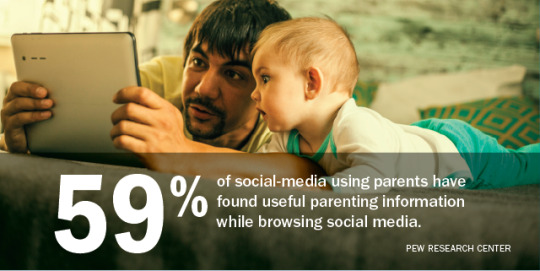
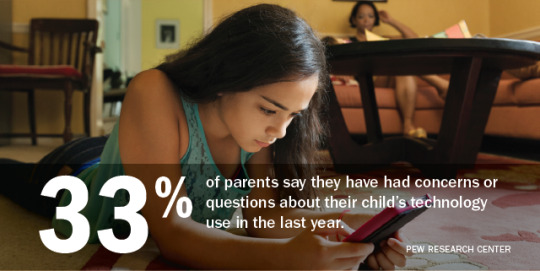

Parents and Social Media
Many U.S. parents use social media to seek parenting-related information and support. Mothers are especially likely to both give and receive support via their networks.
76 notes
·
View notes
Link
The study shows 59% of parents are not concerned with their children becoming “addicted” to new media. In my own experience, I have witnessed my own daughter fall to the ground, kicking and screaming for my phone. I have also discussed the subject with my coworker who has a 6-year-old daughter what would cry and beg to watch the iPad. I have also witnessed my nieces and nephews take each of their tablets to bed with them. I personally cannot condone the entitlement children feel towards these devices. The article even states that the children’s use reflects the family’s own media environment. I have recently been very curious of the correlation between parent’s media usage and their children’s media usage. I have been around adults who will not lift their head from their phone while walking into busy intersections, so I constantly ponder does this behavior change at home when they are with their family? It is a strange concept for adults to not make eye contact due to their screen fixation. They say our children are a direct reflection of ourselves, so is this the behavior we want to pass down?
0 notes
Link
One of my peers posted this video, and I was immediately in awe. The Cubetto not only encourages hands-on learning away from screens but also incorporates coding which is essential in Computer Science. This product allows the kids to be in control and also enables a level of critical thinking they may not have been introduced to yet.
“The London startup promises families and educators a screen-free way to teach coding basics to kids who can’t yet read or write,”- Lora Kolodny
Although the price is a bit hefty for a kids toy, retailing at $225, it is definitely the beginning of integrating age-appropriate toys with the intellectual basics of new media technology. Hopefully, in time these types of beneficial products become more affordable.
0 notes
Link
After reading this interview with a very credible subject matter expert, Bruce D. Perry, M.D., Ph.D., who leads the ChildTrauma Academy I have a little bit more insight on the benefits within the education realm of technology. Perry mentions specialized computer programs that help special needs students that are at-risk or that need assistance with language development. This really is a milestone for people, especially kids, with special needs. Both of my maternal uncles were born with congenital glaucoma, leaving them blind and deaf. My grandmother tells me stories about having to find special braille schools for them growing up. She even had to drive an hour to and from Austin every day to take them to school, because the curriculum was not easily accessible. After a few surgeries, my uncles now have partial vision and also hear with a hearing aid. They find the zoom feature and large font options on the iPhone extremely useful to their everyday life. I can only imagine the abilities the products possess for children today, which is extremely positive. However, even Dr. Perry states,
“While technology can help us teach children, in the end, our children learn from us.”
This is a reminder that alone, technology cannot raise our kids. It is a balancing act, that we are still adjusting to as parents. New media technology is here to stay and it is our job as a community to figure out what is healthy and what is not, to limit and yet to let loose, and to make sure we are giving our kids the skills they need to be successful and positive contributors to society.
“These technologies are revolutionizing the world our children will live in. So our task is to balance appropriate skill-development with technologies with the core principles and experiences necessary to raise healthy children.”
This is a great point of view from both negative and positive sides . This shows the viewers that technolodgy is allowed to be used but not for to long .
2 notes
·
View notes
Link
I really enjoyed this mother’s perspective. She knows we live in the 21st century and she will not be able to avoid tablets forever, but after discussing the Kindle Fire she bought for her 5-year-old daughter with her husband they decided it was best to take it back. To preserve her time before this new technology just a little bit longer, while they can at least. Many education systems use tablets, and in an environmental progressive mindset, I get it. The joys of saving trees by using tablets instead of paperbacks can even sway me but not for every activity.
“I know we can't postpone the inevitable forever. Our daughter may eventually need one of these devices for school, or beg until we can't take it anymore. But I like to think we can nourish her imagination and encourage her to live in the present for just a little longer”
1 note
·
View note
Photo
Sometimes I feel as though I get caught up in the nostalgia of the photos on the left, but I know it is more than that. It is what childhoods are made of, that magical ability we lose as adults, our imagination. I am not saying kids lose their imagination with technology but I do it believe they use it less than they would if they were painting a blank canvas or building a block house. Every day I get to witness how my toddlers flourish during arts & crafts time or at the park and on the contrary how restless they get in front of the TV after 30 minutes.



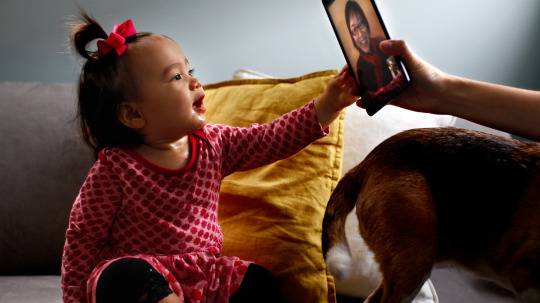

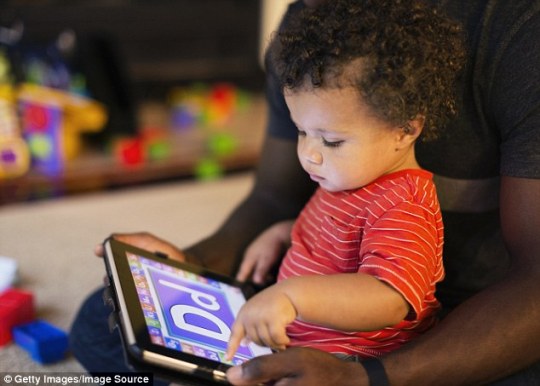



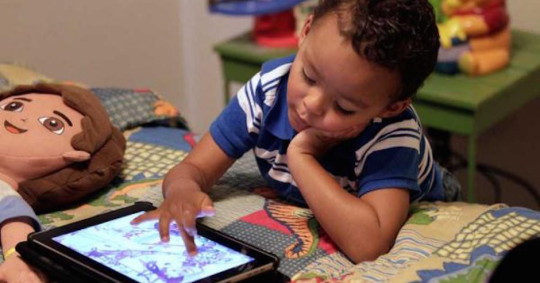
The left hand side of this photo grid displays five images of what I believe healthy learning and social interaction should look like. For example, the bottom left hand image is of a child engaging with play dough. Play dough is not only fun for the child, but it also gives them the ability to develop fine motor skills, creativity and hand-eye co-ordination. The opposite side of the photo grid also displays five images of children, except they are each with different forms of technology. I will not argue the fact that children cannot benefit from such devices, but I will argue the fact that they are the better option.
1 note
·
View note
Link
On the other side of the spectrum, technology can be a vital asset for children with disabilities. Reading stories similar to this I am often reminded how lucky our generation and culture are to have accessibility to these gadgets. These devices have a major impact on children with disabilities. For example, they are able to engage in apps such as Peek-A-Boo Barn which uses animal sounds and repetitive actions. Interactive books are also available. Although, I do not condone tablet or smartphone use in my home, I am still aware of how my views might alter depending on my daughters vision impairment.
2 notes
·
View notes
Photo
This is my first time seeing this type of iPhone device/toy. The is very bothersome for me. It seems very unnecessary to add an iPhone holder to the toy. My kids loved these toys, they used their imaginations and made their own music. I feel as though instead of shaking the toy and actually playing they will be glued to the screen if they had this item. Why add something to an already effective toy?

10 notes
·
View notes
Link
When I was in the Navy I worked in a Public Affairs office as a Mass Communication Specialist, that is where I actually realized the value of writing in every aspect. My boss asked me, “do you know the one job computers can’t replace?” As this was a random question I stood there waiting for his reply, “journalism,” he said. This made me think about what he meant, then I thought about the actual art of taking a pencil to paper. In our generation everything is turned in and submitted by computers although the nostalgia of writing with paper and pencil still resonates with me I do understand the reasoning behind the electronic transfer. However, shouldn’t kids know that writing nostalgia like we do? Not only for memories and skills sake but more so for their cognitive development. Researchers say writing is an important developmental process that requires complex brain power. Writing requires visual, motor, and cognitive skills and processes essential in child in development. All of this information is in comparison to children using a keyboard instead. Although, it is a lot to take in, raising happy, healthy, and bright children makes the extra effort in learning how our daily technology affects them worth it.
1 note
·
View note